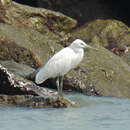Biology
(
Inglês
)
fornecido por Arkive
Shortly before the spring migration to the breeding grounds the Chinese egret acquires its breeding plumage. Breeding takes place on offshore islands amongst breeding colonies of other species, on cliffs or in trees and low bushes. The disc-shaped nest is built of straw and creeping plants, and in it the female lays between three and five eggs. They are incubated by the female for 24 to 30 days, and the hatchlings remain in the nest for a further 36 to 40 days being fed crabs and fish by the female (4).
The Chinese egret is a feisty feeder, running after the receding tide with open wings to catch mobile prey, such as crabs and other invertebrates. It is often found feeding amongst other heron species, and will take fish and shrimps when possible (4).
Conservation
(
Inglês
)
fornecido por Arkive
The Chinese egret is legally protected in Russia, China and South Korea, and benefits from protected land covering several key breeding, staging and wintering sites. Proposed measures to conserve this species include the creation of a network of environmentally stable sites in the central Philippines and the extension of the boundaries in the Far Eastern Marine Reserve. It is crucial to establish further protected areas and to prohibit the collection of eggs in China and North Korea (2).
Description
(
Inglês
)
fornecido por Arkive
This beautifully elegant member of the heron family is characterised by its long legs, neck and bill, and upright body. It has a drooping head-crest and bluish facial skin running from the orange bill through the eye. Its feathers are pure white, and especially long on the back and breast. The legs are black but the feet are greenish-yellow (2).
Habitat
(
Inglês
)
fornecido por Arkive
Inhabits shallow tidal estuaries, mudflats and bays, and may also be seen in paddy fields and fishponds (2).
Range
(
Inglês
)
fornecido por Arkive
Occupying Russia, North Korea, South Korea and mainland China during the breeding season, the Chinese egret used to breed also in Taiwan and Hong Kong, but is now just a non-breeding visitor. It also visits Japan, the Philippines, Vietnam, Thailand, Peninsular and eastern Malaysia, Singapore, Indonesia and Brunei as a non-breeder. It migrates to the eastern Visavas of the Philippines for the winter. It is not thought to have declined significantly in the last decade (2).
Status
(
Inglês
)
fornecido por Arkive
The Chinese egret is classified as Vulnerable (VU) on the IUCN Red List 2007 (1) and is listed on Appendix I of the Convention on Migratory Species (CMS or Bonn Convention) (3).
Threats
(
Inglês
)
fornecido por Arkive
Demand for the beautiful plumes of the Chinese egret threatened to drive this species to extinction before the end of the 19th Century, although this has been refuted by some authorities. Declines continued into the last century, due to habitat loss and degradation following conversion of tidal flats and estuaries to areas for aquaculture, agriculture and industry. In China, it is disturbed by egg collectors and photographers and breeding success is consequently reduced. In particular, disturbance by photographers in the 1990s caused a colony in South Korea to suffer startling declines (2).

